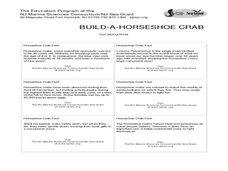Curated OER
Graphic Organizer-- Spider Map
For this graphic organizer worksheet students may use this helpful tool to organize facts on any subject. The spider map refers to the way this looks with a center main topic and specific facts coming out on the "legs".
American Museum of Natural History
Saving Species
Some scientists dedicate their lives to researching and protecting endangered species. An online lesson teaches about three scientists around the world who do just that. They learn about spiders, mollusks, and reptiles from North...
Curated OER
Spiders
First graders complete a variety of center activities to study spider characteristics and facts. They solve math problems, identify spider body parts, and study vocabulary words to use in creative writing about spiders.
Curated OER
Spider Spider Math Game
In this spider spider math game worksheet, students follow the instructions to play the math game that requires them to use their multiplication skills.
Curated OER
Woodland Math Facts
In this Woodland math facts worksheet, students study and examine woodland weights of trees and shrubs, explore invertebrates and draw a bar chart to chart their findings.
Curated OER
Chalkboard Challenge: Animals
This animal science PowerPoint engages students in a review game about animals. This interactive game is in a "Jeopardy" style format and allows students to review facts about mammals, birds and other animals.
Curated OER
Commotion About Motion
Second graders are introduced to different types of motion. They make rolling spider toys and race them on different surfaces to invsetigate forces and motion. Pupils make glue "spider webs" for their spiders after testing different...
Poetry4kids
How to Write a Traditional “Mother Goose” Nursery Rhyme
There may be some little lambs, itsy bitsy spiders, and pumpkin eaters in your language arts class! An online poetry lesson takes learners through the steps of writing a nursery rhyme with easy-to-follow steps and explanatory examples.
PreKinders
Poison Dart Frogs
Learn about the poison dart frogs of the rainforest with a slide show that features facts and pictures. Each slide educates viewers about poison dart frogs, such as where they live, what they eat, and how they are poisonous.
Biology Junction
World of Insects: Characteristics, Orders, and Collecting
Every bug is an insect, but not all insects are bugs. A presentation lists the characteristics of insects, describes their body parts, and explains metamorphosis. It also details every order and includes photographs and multiple facts...
Curated OER
The Spider and the Fly
Students investigate maxima and minima by finding the shortest distance. In this calculus lesson, students calculate the shortest distance a bug travels to get to the other side of the tv. They analyze their findings discussing minimum...
California Academy of Science
The Heat is On: Cause and Effect and Climate
The higher the number of letters in the final word for the National Spelling Bee, the higher the number of people killed by venomous spiders. Obviously, those two facts correlate, but no causation exists. Scholars view data based on...
Curated OER
Science: How to Identify Insects
First graders discover how to distinguish spiders from insects by understanding the characteristics of each. They sort online picture pages into the two groups and examine the insects for common attributes. Students complete a worksheet...
Curated OER
Animal Diary
Students create a diary of an animal. In this creative writing lesson plan, students read the book Diary of a Worm and conduct a brief research session on their animal. Students fill in a template with facts and create an animal diary.
Curated OER
Alliteration Fun with Spiders
Students practice using vocabulary words to write alliterations. In this language arts lesson, students collaborate with classmates to create ideas for fun alliterations as they create their own using a children's word processing...
Curated OER
Animals A to Z: Gecko
For this editing sentences worksheet, students read and edit five sentences about geckos to find ten errors involving capitalization, punctuation, spelling and/or grammar. Students correct each error.
Curated OER
Anansi Goes To Lunch
Students read and explore a folktale from West Africa. In this folktale lesson, students read the book Anansi Goes to Lunch and discuss facts about spiders. Students sing the song "The Itsy Bitsy Spider" and complete several included...
Curated OER
Desert Creepy Crawlies- Research Skills
For this science worksheet, students research information about 4 desert animals and write facts on the lines. Students write information about the Hercules Beetle, Harvester Ants, Giant Red Velvet Mites and Yucca Moths.
Curated OER
Build-A-Horseshoe Crab
Students discover many facts about horseshoe crabs. Students identify the main body parts of horseshoe crab. They explore the habits of the horseshoe crab and their importances to the ecosystem. Adaptations for younger students are...
Curated OER
Diversity of Arthropods
For this arthropods worksheet, students will review the characteristics of the different types of arthropods including spiders, ticks, crustaceans, millipedes, and insects. Students will also understand the difference between complete...
Curated OER
Where Plants and Animals Live
Students explore and discuss facts about a woodland environment, the plants and animals that live there, and changing seasons in the woods. They conclude that plants in the woods provide food and shelter for animals living there.
Curated OER
Ant City
Learners develop an ant colony that adults and children can visit. Students create different areas including places where tourists can view live ants, play ant games, research facts about ants, and create ant art. Learners serve as...
Curated OER
For Creative Minds: Tudley Didn't Know
Students discover facts about the animals in John Himmselman's book, Tudley Didn't Know, and make a paper turtle. In this marsh animals instructional activity, students first read the book Tudley Didn't Know. Students read facts about...
Curated OER
Arthropod Coloring
In this arthropod worksheet, students compare and contrast the different animals found in the Phylum Arthropoda: insects, arachnids, and crustaceans. Students complete 8 fill in the blank statements and color illustrations.

























